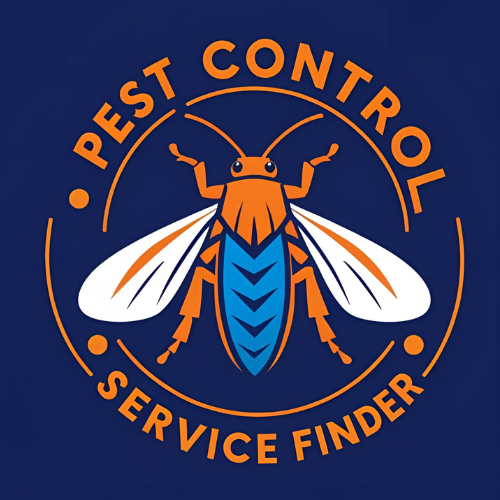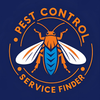Emergency pest control: Quick Guide for Urgent Situations
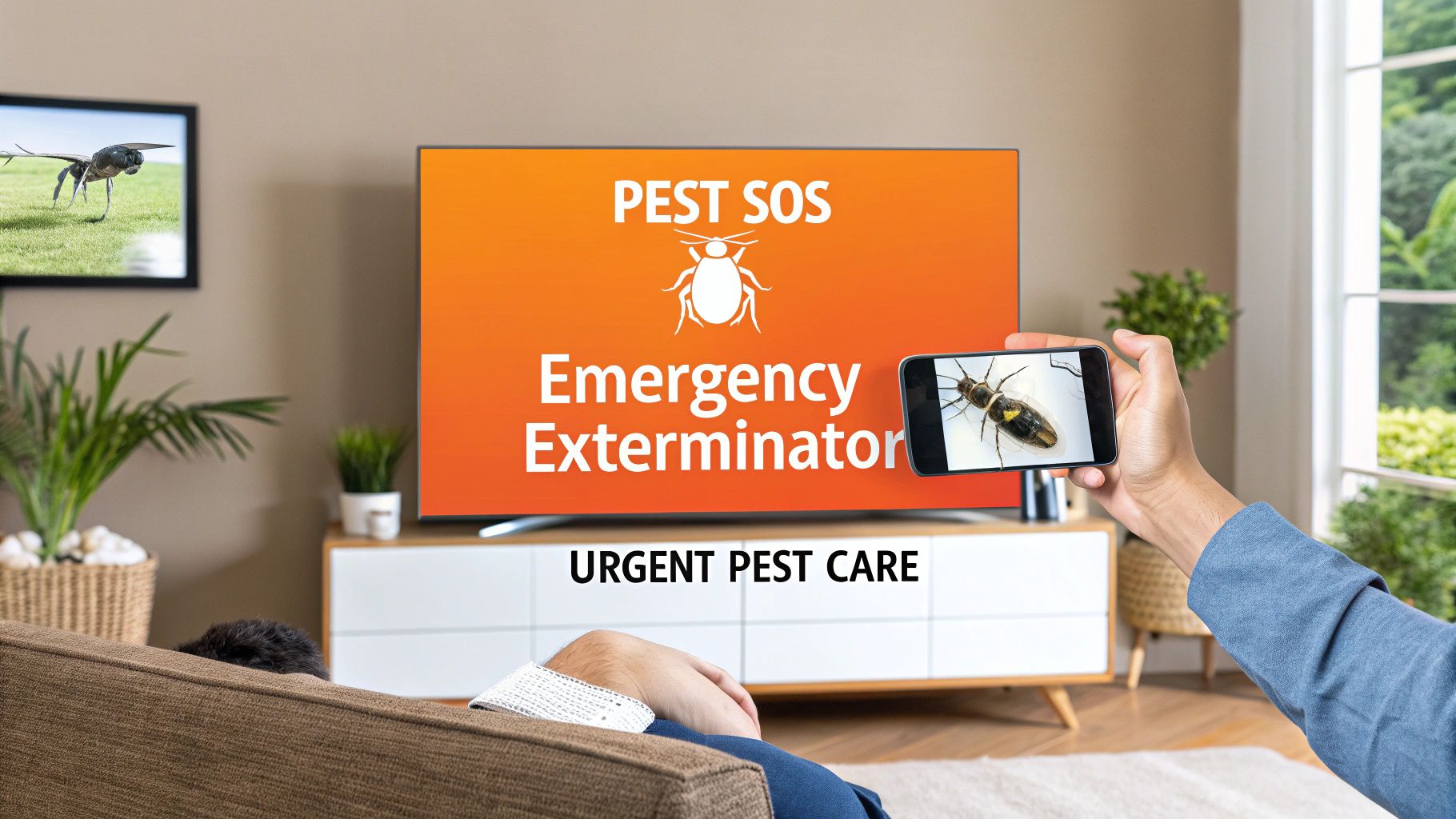
Pests are a problem. You should spray them. Right?
Wrong. This is a common mistake. Spraying pests can scatter them. They run deeper into your walls. This makes the problem much worse.
Your first step isn't to attack. It's to stay safe. And to contain the problem. For immediate expert advice on what to do, you can always Call +1 855 224 3071.
Your First Moves in a Pest Emergency
When you stumble upon a swarm of insects or a rodent nest, the adrenaline kicks in. But that frantic moment is exactly when you need a clear head. Instead of reaching for a chemical that might endanger your family or just annoy the pests, the right move is to secure the area, isolate the problem, and then call for help.
Taking these calm, measured steps can keep a localized issue from turning into a full-blown crisis that takes over your entire home. The process is simpler than you think. If you need someone to walk you through it, Call +1 855 224 3071 for fast assistance.
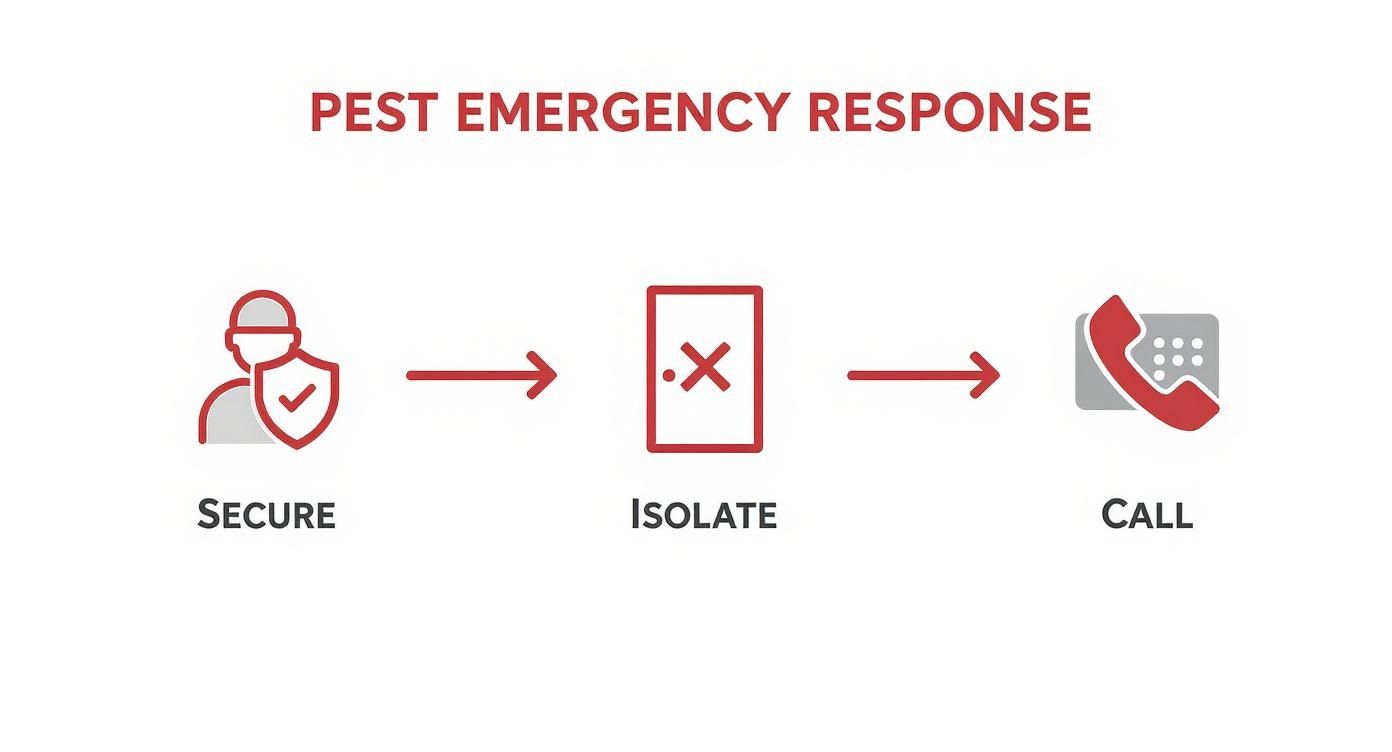
As you can see, calling a pro is the last step, not the first. Getting the scene safe is always priority number one.
Different pests require different immediate actions to keep things from getting out of hand while you wait for a professional.
Immediate Actions for Common Pest Emergencies
This table provides quick, actionable first steps for different types of urgent pest situations to ensure immediate safety and containment.
| Pest Type | Immediate Safety Concern | Containment Action |
|---|---|---|
| Wasps/Hornets | Stings and allergic reactions. | Calmly evacuate the area. Do not spray or throw things at the nest. Close nearby windows and doors. |
| Cockroaches | Food contamination, spreading bacteria. | Remove all open food, pet bowls, and accessible trash from the area. Close the door to the room. |
| Bed Bugs | Spreading to other rooms via clothing/linens. | Avoid moving bedding, furniture, or clothes from the infested room. Isolate the room. |
| Rodents (Mice/Rats) | Bites, disease transmission, property damage. | Keep pets and children away. Close the door and block any gaps at the bottom with a towel. |
| Ant Swarm | Contaminating surfaces, potential for multiple colonies. | Wipe up visible trails with soapy water to disrupt pheromones. Seal any visible entry points with tape. |
| Fleas | Bites, spreading to pets and throughout the house. | Isolate any infested pets to a single, easy-to-clean room (like a bathroom) if possible. Vacuum the area thoroughly. |
These steps are about minimizing risk and spread, not eliminating the pest. That's a job for the experts.
Isolate the Infestation to Stop the Spread
Once people and pets are safe, your next job is containment. Pests are opportunists—give them an opening, and they’ll migrate to other parts of your home in a heartbeat. A cockroach problem in the kitchen is bad; one that spreads to every room is a nightmare.
A simple rolled-up towel pushed against the bottom of a door can be a surprisingly effective temporary barrier against many crawling insects and even some small rodents, buying you valuable time until a professional arrives.
Simple actions make a huge difference here. Close the door to the infested room. See a gap underneath? Block it. If you can see pests coming from a specific crack in the wall or a hole near a pipe, cover it with duct tape. This isn't a permanent fix, of course, but it stops the immediate flow.
The global pest control market is expected to hit USD 53.1 billion by 2035, which tells you just how common—and serious—these situations are.
Avoid Making the Problem Worse
What you don't do is just as critical as what you do. Please, avoid these classic mistakes that can turn an emergency into a catastrophe:
- Don't Use "Bug Bombs" or Foggers: These over-the-counter products are mostly useless. The mist rarely gets into the cracks and crevices where pests actually live, and more often than not, it just drives them deeper into your home's structure.
- Don't Disturb Nests: Found a wasp nest or a rat's den? Leave it alone. Poking, spraying, or otherwise agitating it is a surefire way to provoke an aggressive, defensive attack.
- Don't Seal Pests In: While blocking obvious entry points is smart, be careful not to trap pests inside your walls without a way for a professional to treat them. A trapped rodent will just chew a new hole somewhere else, maybe right into your living room.
Managing any home crisis, whether it’s pests or water damage, requires the same clear-headed approach. You can see similar principles in guides on handling emergency water cleanup.
Once you’ve secured the area and contained the issue as best you can, it's time to make the call. For a fast connection to a vetted, local pro who handles urgent situations, Call +1 855 224 3071 anytime.
How to Find a Reputable Same-Day Exterminator
When you're dealing with a full-blown pest emergency, the gut reaction is to hire the first person who can show up. I get it. The panic is real. But hiring the wrong company can make a bad situation catastrophic, leading to botched treatments, safety hazards, and a much bigger bill down the line.
The trick is to find someone who is both fast and good. It's totally possible to vet a company in minutes without wasting precious time. You just need to know what to look for and what questions to ask.
Start With a Targeted Online Search
Don't just type "exterminator" into Google. You need to be specific to filter out the slowpokes. Use phrases like "emergency pest control near me" or "24-hour exterminator for cockroaches." This immediately narrows your results to companies that are actually set up for urgent calls.
Once you have a list, skip the paid ads at the very top. Look for their Google Business Profile and scan the reviews. A steady stream of recent 4- and 5-star ratings is what you want to see. For a deeper dive on vetting local pros, our guide on finding pest control services near me is a lifesaver.
Make the Right Call and Ask Critical Questions
When you get someone on the phone, you're in charge. The person on the other end of the line should sound professional, calm, and ready to answer your questions directly. If they're pushy, vague, or seem annoyed by your questions, hang up and move on. You can get a professional on the line right away if you Call +1 855 224 3071.
Here’s your quick script of what to ask:
- Licensing and Insurance: "Are you licensed and insured to operate in my state?" This is a deal-breaker. A legitimate pro will have this info on hand, no hesitation.
- Specific Experience: "How much experience do you have with [your specific pest]?" A company that handles rats all day might not be the best choice for a tricky bed bug infestation.
- Technician Credentials: "Are your technicians certified and have they passed background checks?" You need to trust the person coming into your home, especially during a stressful time.
A seasoned dispatcher won't just take your address. They'll ask smart questions about what you're seeing, where you're seeing it, and how bad it is. This tells you they have a real process and are preparing the technician for the job.
If you're too overwhelmed to make these calls, a direct line can cut through the noise. Call +1 855 224 3071 to connect with a pre-screened, local emergency pest specialist who is already vetted.
Spotting Red Flags Before You Hire
In a rush, it’s easy to miss the warning signs of a shady operator. A true professional will be transparent and reassuring from the very first call.
Watch out for these classic red flags:
- Vague Pricing: If they can't give you a clear range for their emergency call-out fee or inspection cost over the phone, run. Avoid anyone who says, "We'll figure it out when we get there."
- Unmarked Vehicles: A professional company arrives in a branded truck or van. An unmarked white van screams amateur hour.
- High-Pressure Sales Tactics: Their job is to solve your immediate problem, not scare you into a costly long-term contract on the spot.
- No Guarantees: Ask what kind of service guarantee or warranty they offer. A reputable company stands behind its work and will schedule a follow-up if the pests return.
Choosing the right expert is the single most important decision you'll make. A real pro doesn't just kill the bugs; they restore your peace of mind and ensure the job was done safely. Making the right call is everything. For immediate help from a trusted professional, don’t hesitate to Call +1 855 224 3071.
What Happens During an Emergency Service Visit
Forget the Hollywood image of an exterminator kicking down the door and fogging the entire house. That’s not how real pros handle a crisis. A legitimate emergency visit is careful, strategic, and puts your family’s safety first.
Knowing what a real service call looks like helps you stay in control during a stressful situation. You'll know what questions to ask and can feel confident the job is being done right. If you're ever unsure about what a company is telling you, it's a good sign to get a second opinion. You can always Call +1 855 224 3071 for a no-nonsense explanation of professional standards.
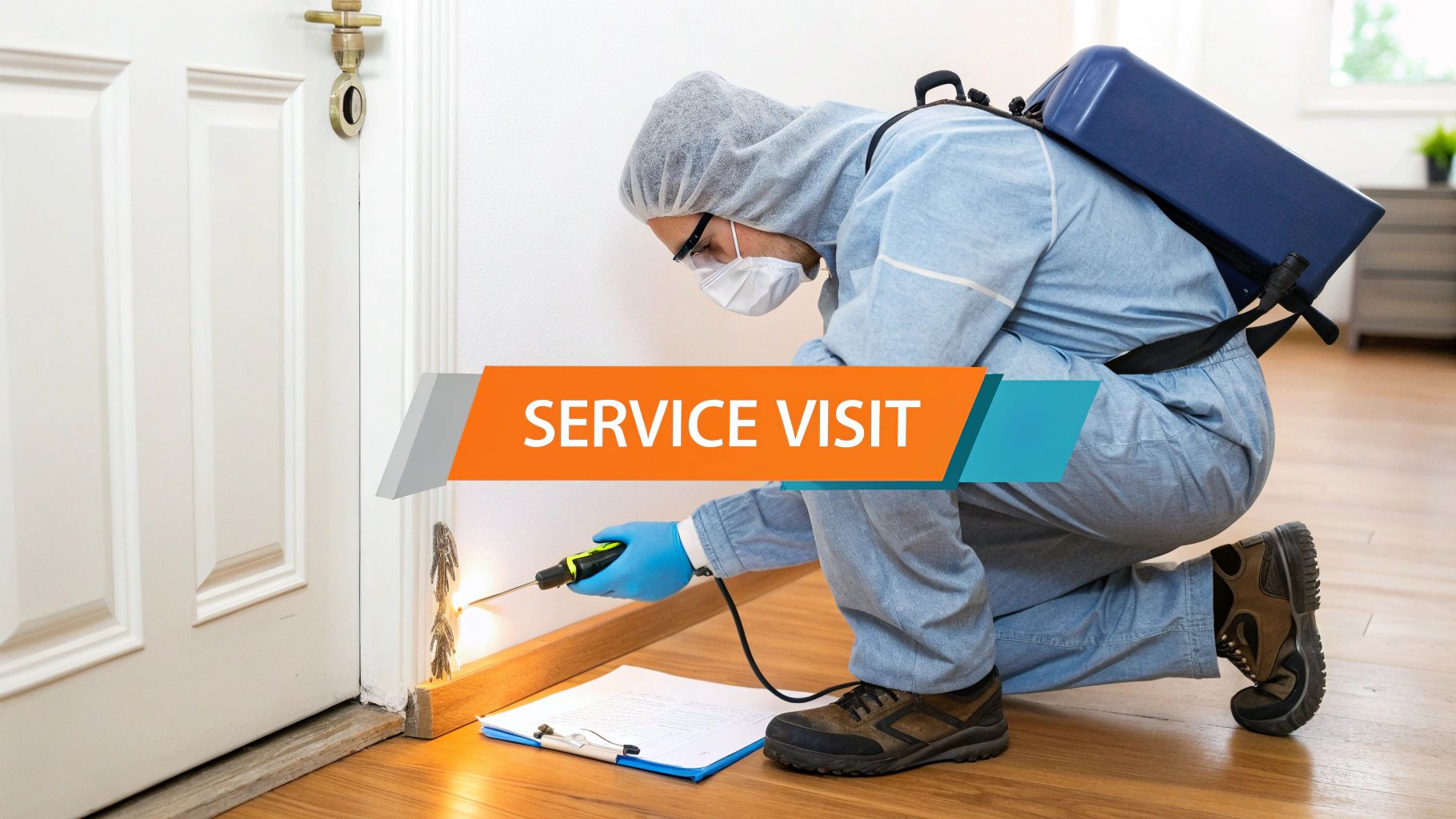
The Initial Arrival and Inspection
The first thing a technician does isn't spray—it's investigate. They can't solve a problem until they know exactly what they're up against. This is the single most important part of the visit.
They’ll start by talking to you. Be ready to give them the key details:
- What kind of pests are you seeing?
- Where did you see them, and how many?
- When did this all start?
- Do you have any kids or pets at home?
Next comes the real detective work. A pro won't just glance around. They’ll grab a flashlight and start looking for the source: entry points, nests, droppings, and other signs of pest activity, often far from where you saw the first bug.
If you called about roaches in the kitchen, for example, they won’t just check under your sink. They’ll be pulling out the fridge, inspecting cabinets, checking plumbing lines, and even looking in adjacent rooms. This thoroughness is what separates a temporary fix from a lasting solution.
Tailoring the Treatment Plan
After the inspection, the technician will walk you through what they found and recommend a plan of action. This is never a one-size-fits-all deal. The right method depends entirely on the pest, how bad the infestation is, and your home’s layout.
A bed bug emergency might call for a mix of targeted insecticides and a powerful heat treatment. A rat problem, on the other hand, requires strategic trapping and, most importantly, sealing up every hole they're using to get inside.
A true professional’s goal is to use the minimum amount of product needed to be effective. This targeted approach is far safer for your family and works better than just spraying everything down.
Now is your time to ask questions. Don't hold back. What products are they using? Are they safe for your pets and kids? What do you need to do before they start? A good technician will have clear, confident answers. If the person you're talking to seems vague or can't give you straight answers, that's a red flag. Call +1 855 224 3071 to connect with a team that can.
Implementing the Treatment and Ensuring Safety
Once you’ve approved the plan, the technician gets to work. They’ll be wearing the proper personal protective equipment (PPE) and will treat the infested areas methodically. They will likely ask you to keep children and pets away from treated rooms for a set amount of time.
Safety is everything. Professionals are trained to apply products where pests live and hide—inside wall voids, deep in cracks and crevices—not on open surfaces where your family could be exposed.
While the pest control industry has many tools, chemical control remains a cornerstone. The global insect pest control market is projected to be worth USD 12.02 billion in 2025, a testament to the effectiveness of these products when handled by licensed experts. You can see more data on the global pest control services market to understand the industry's scale.
When the job is done, they’ll give you clear post-treatment instructions. This part is critical. They’ll tell you when it’s safe to return, how to air out your home, and what to expect over the next few days. (Hint: sometimes you’ll see more pests at first as they’re flushed out of hiding.)
You should also get paperwork detailing what they did, the products they used, and any necessary follow-up steps. A reliable emergency service doesn't just disappear. The job is finished when your home is secure and your peace of mind is restored. For that level of professional care, keep our number handy: Call +1 855 224 3071.
Breaking Down the Costs of Emergency Pest Control
Most people assume an emergency pest control call comes with a single, massive price tag. But it’s not that simple. The final cost isn't a flat fee; it's a calculation based on several moving parts, from the type of bug you’re dealing with to the exact time you pick up the phone.
The price of an after-hours service is a huge worry during an already stressful moment. But it doesn't have to be a complete mystery. Understanding what drives the cost puts you back in control and helps you avoid sticker shock when the bill arrives.
Key Factors That Influence Your Final Bill
A professional service will be upfront about what goes into their pricing. The most significant cost drivers are almost always the same. For a clear, immediate quote based on your specific situation, you can Call +1 855 224 3071 to speak with someone who can walk you through it.
Here’s what really moves the needle on your bill:
- The Type of Pest: This is the big one. Eradicating a complex bed bug infestation, which might require specialized heat treatments, is a completely different job than handling a localized ant swarm. Pests like termites or wood-boring beetles also command higher prices because of the structural risk and the intensive treatments needed to stop them.
- Infestation Size and Severity: A small, contained wasp nest on your back porch is a much quicker—and cheaper—job than a deeply entrenched German cockroach problem that has spread through your kitchen walls. The more widespread the issue, the more time, labor, and product it takes to solve it.
- Time of Service: A call at 2 AM on a Sunday will naturally cost more than a call during normal business hours. That premium covers the technician's overtime pay and the on-demand nature of the response. It’s the price of immediate peace of mind.
Don't be afraid to ask for a detailed breakdown. A reputable company should have no problem explaining exactly what their emergency fee covers and what services are included in that initial price.
These three factors set the baseline for any quote you get. From there, a few other details come into play.
How Treatment Methods and Property Size Affect Price
Beyond the pest itself, the specific solution required and the size of your home are crucial. A larger home with more potential hiding spots simply takes longer to inspect and treat, which increases labor costs. A 3,500 sq ft house will always cost more to treat than a 900 sq ft apartment for the same pest.
The treatment method is another major variable. A standard chemical spray application is usually less expensive than a non-toxic heat treatment for bed bugs, which requires bringing in powerful equipment to raise a room's temperature to lethal levels. Fumigation (or "tenting") for termites is one of the most expensive treatments out there because of the materials, intense labor, and the fact that your family has to vacate the home.
You can learn more about how these services are priced in our complete guide to the cost of pest control services.
Cost Influencing Factors for Emergency Services
When you get an emergency quote, it’s not just one number—it’s a combination of these factors. Knowing what they are helps you understand exactly what you’re paying for.
This table breaks down the main variables that determine what you'll pay for an urgent visit.
| Factor | Description of Impact on Cost | Example |
|---|---|---|
| Pest Type | More resilient or dangerous pests require specialized, often more expensive, treatments. | Bed bug heat treatments are more costly than a standard cockroach spray. |
| Infestation Severity | A widespread, deeply rooted infestation requires more labor, product, and time to resolve. | A single rodent is cheaper to handle than a large, established nest in the attic. |
| Timing of Call | After-hours, weekend, and holiday calls carry a premium fee for immediate response. | A 10 PM Saturday call will cost more than a 10 AM Tuesday call for the same issue. |
| Treatment Method | The technology and materials used directly influence the price. | Eco-friendly or non-toxic options can sometimes be more expensive than traditional chemicals. |
| Property Size | Larger homes or properties with complex layouts take longer to inspect and treat. | Treating a 3,500 sq ft house costs more than a 900 sq ft apartment. |
Getting a clear, itemized quote before any work begins is non-negotiable. If a company is hesitant to provide one over the phone, that’s a major red flag. For a transparent quote right now, Call +1 855 224 3071 and get the clarity you need.
Post-Treatment Steps to Keep Your Home Safe
So the exterminator's truck has pulled away. You might feel like the battle is over, but this is a common mistake. The first few hours and days after a treatment are just as critical as the service itself—this is what ensures the pests are gone for good and your family stays safe.
What you do next can be the difference between a one-time fix and a recurring nightmare. It’s not just about airing out the house; it’s a strategic process. If you have any immediate questions about what’s safe and what’s not, don't wait. Call +1 855 224 3071 for clear, direct guidance.

Following Your Technician's Instructions
Your technician is your single best source of information. They know the exact products they used and how the pests in your home behave. They’ll give you a clear set of instructions—following them to the letter is non-negotiable.
Here’s what that guidance usually covers:
- Re-entry Time: This is the big one. The tech will give you a specific timeframe, often 2-4 hours, before it’s safe for people and pets to come back inside. This allows sprays to dry completely and any airborne particles to settle.
- Ventilation: The moment you walk back in, open the windows and doors. Getting a good cross-breeze going helps clear out any lingering odors and makes sure the air quality is safe for everyone.
- Cleaning Protocol: Pay close attention here. You’ll be told not to clean floors, baseboards, or other treated surfaces for a while, sometimes up to a week. Aggressive cleaning with detergents will wipe away the residual barrier that’s designed to keep killing pests long after the technician has left.
A lot of modern pest treatments are designed to work over time. Pests crawl across a treated barrier, pick up the product, and unknowingly carry it back to their nests. This is what wipes out the entire colony. If you scrub that barrier away, the treatment becomes far less effective.
Managing Expectations in the Days Following Treatment
This might sound backward, but it's totally normal to see more pest activity for a day or two after the service. Don't panic—this is usually a good sign. The treatment is flushing pests out of their hiding spots in walls, voids, and crevices, forcing them out into the open where they're exposed.
These pests are disoriented and on their way out. Resist the urge to squash every single bug you see. You want them to cross the treated surfaces so the product can do its job on a wider scale. If you're ever worried about the amount of activity, a quick call can put your mind at ease. Call +1 855 224 3071 to find out what's normal and what isn’t.
Safe Cleaning Practices and Long-Term Prevention
Once the recommended waiting period is over, you can get back to your cleaning routine, but with a few adjustments. Focus on wiping down food prep surfaces, countertops, and tables with soap and water. You should also clean any children's toys or pet bowls that might have been nearby. For a deeper dive, check out our guide on choosing a safe indoor insect spray and the best ways to use it.
This is also the perfect moment to shift your focus to prevention. The technician probably pointed out the entry points and conditions that attracted the pests in the first place. Now is the time to act on that info.
Your Proactive Prevention Checklist:
- Seal Entry Points: Grab some caulk or steel wool and seal every crack, gap, or hole the technician showed you around pipes, windows, and along your foundation.
- Eliminate Food and Water: Fix leaky faucets, be vigilant about cleaning up crumbs, and store all food—including pet food—in airtight containers.
- Schedule Follow-Up Visits: Many emergency treatments include a guarantee or a recommended follow-up visit. This is crucial for breaking the pest life cycle and ensuring the infestation is truly gone for good.
Your active participation after the treatment is what locks in the results and helps you reclaim your home.
Got a Pest Emergency? Here Are the Real Answers
Most people picture a pest emergency as a scene from a horror movie—a massive swarm, something dramatic. But often, the real emergency is much quieter. It's the moment you find termite damage in your walls or realize the few ants you saw last week have become an army marching through your kitchen.
The truth is, any pest that puts your health, property, or sanity on the line is an emergency. When you're in that stressful moment, knowing the answers to a few common questions can help you cut through the panic and take the right action, fast.
Is This Really an Emergency?
This is the first thing people ask themselves, usually second-guessing if they should "bother" an exterminator. Here’s the deal: an emergency pest control situation isn't just about a sudden swarm of bees. It's any scenario where pests pose an immediate threat.
These situations are definite emergencies:
- Health Hazards: Finding rodents, cockroaches, or fleas is a big deal. These pests can spread diseases and trigger serious allergies, demanding immediate professional help.
- Aggressive Pests: A wasp or hornet nest hanging over your porch, near a kid's play area, or blocking a doorway is a clear and present danger. This is not a DIY job.
- Property Destruction: See active termites or carpenter ants? Your home's structure is literally being eaten. Waiting is not an option—every day means more damage.
- Sudden, Massive Infestations: Discovering bed bugs or seeing a sudden explosion in the number of any pest means you need to contain it before it takes over your entire home.
If it feels urgent to you, it probably is. Trust your gut. For a professional opinion on what you're dealing with, Call +1 855 224 3071 for immediate advice.
Can I Just Handle This Myself?
It’s tempting to grab a can of bug spray from the garage. It feels like you're doing something, but it's often the worst move you can make. Those over-the-counter products are almost never strong enough to eliminate the source of the problem.
Worse, a DIY attempt can make the infestation spread. Spraying a line of ants, for instance, only kills the foragers you see. It does nothing to the thousands hiding in the nest. In fact, it can trigger a defensive response called "budding," where the colony splits into several new colonies, spreading your problem into new rooms.
Pros use targeted, commercial-grade products and strategies that go beyond just killing what's visible. They aim to wipe out the source and break the pest's life cycle—something a generic fogger or spray simply can't do.
What’s This Going to Cost Me?
The price for emergency pest control can vary a lot. It really depends on the type of pest, how bad the infestation is, and when you call. A late-night or weekend call will naturally come with a premium fee.
But here’s the key: a reputable company will be completely upfront about its pricing on that first phone call. They should give you a clear estimate for the initial inspection and visit. If a company is vague about costs or pressures you to agree to service before giving you a quote, hang up.
For a transparent, no-obligation estimate, Call +1 855 224 3071 right now.
How Fast Can Someone Get Here?
When it's a true emergency, you need someone now. Most companies offering emergency pest control provide same-day service, often promising a technician at your home within a few hours.
When you call, make sure to ask for their estimated arrival time. A professional service gets the urgency and will prioritize your call, especially if it involves a health or safety risk. Their entire operation is built to handle these calls around the clock.
Is the Treatment Safe for My Family and Pets?
This is the number one concern for most families, and for good reason. The good news is that modern pest control is worlds away from the old "spray everything" approach. Technicians are trained to use methods that are tough on pests but safe for your home.
They use strategies from Integrated Pest Management (IPM), which focuses on applying treatments in targeted areas where pests live and hide—think inside wall voids, behind baseboards, and in crawl spaces. This minimizes exposure in your main living areas. They also have access to a variety of low-impact, family-friendly products.
Just be sure to tell the company you have children or pets so they can design the safest possible treatment plan for you.
When you're facing a pest crisis, you need a solution that's fast, effective, and safe. Pest Control Service Finder connects you with pre-vetted, local professionals who are on call 24/7 for emergencies. Get immediate help and take back your home by visiting Pest Control Service Finder.
